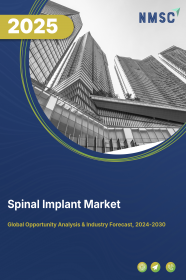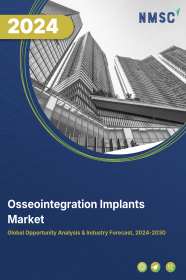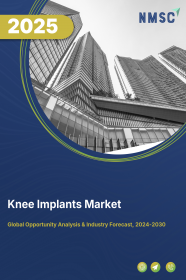
Spinal Implant Market by Product Type (Artificial Discs, Dynamic Stabilization Devices, Spinal Fusion Implants, Plates, and Cages), by Material (Stainless Steel, Titanium, Cobalt Chrome, and Polyetheretherketone), by Indication ( Spinal Trauma and Deformity), by Application (Cervical, Thoracic, and Lumber), by Procedure (Open Surgery, Minimally Invasive Surgery, and Others) and Others– Global Opportunity Analysis and Industry Forecast 2024-2030
Market Definition
The Spinal Implant Market size was valued at USD 15.06 billion in 2023 and is predicted to reach USD 21.88 billion by 2030 with a CAGR of 5.5% from 2024-2030.
Spinal implants are medical devices used in orthopedic and neurosurgical procedures to stabilize and support the spine. These implants are typically made of biocompatible materials such as titanium or stainless steel and are designed to be surgically implanted into the spine to correct deformities, alleviate pain, and improve spinal stability. Spinal implants include rods, screws, plates, cages, and interbody fusion devices. They are used in procedures such as spinal fusion, vertebral fracture repair, and correction of spinal deformities. Spinal implants provide structural support to the spine, promote bone fusion, and help maintain proper spinal alignment, thereby restoring function and relieving symptoms for patients with various spinal conditions.
Market Dynamics and Trends
The growth of the spinal implant market is propelled by the rising incidence of spinal disorders, such as tetraplegia and paraplegia, that necessitates medical interventions and solutions to address spinal conditions effectively. Spinal implants play a crucial role in this regard by providing stability, support, and correction for spinal disorders, ultimately enhancing patient mobility and alleviating pain.
For instance, in April 2022, Spinal Simplicity introduced a medical device, the Minuteman G5 implant, designed for the fixation and stabilization of the thoracic, lumbar, and sacral spine. The G5 implant is equipped with innovative features such as full control over the implant wings, a single-piece implant body, and a hydroxyapatite-coated fixation hex nut. Such innovations not only attract physicians seeking advanced treatment options but also provide patients with enhanced outcomes, thus driving the growing adoption rate of spinal implants on a global scale.
Also, the increasing elderly population leads to a rise in the incidence of spinal deformities which propels the spinal implant market globally. With aging, degenerative spinal diseases such as degenerative spinal stenosis, degenerative disc disorder, and adult spinal deformity increase which results in a growing need for spinal surgery.
As per the report of the World Health Organization, the proportion of the population aged 60 years and above is expected to increase to 1.4 billion by 2030 and is expected to double by the end of 2050. The report also states that the number of people aged 80 years or older is expected to reach 426 million between 2020 and 2050. The increase in the elderly population augments the incidence of spinal deformities, thereby driving growth in the spinal implant market.
However, the high cost of spinal implants and associated procedures poses a significant barrier for many patients with low income, hindering their ability to access the treatment. Consequently, this limitation restricts the adoption and growth of the spinal implants in regions with low income.
On the contrary, the advancement of minimally invasive surgery is expected to result in faster recovery times and decrease patient trauma, thereby boosting the adoption rates of spinal implants in the coming future. It expands access to a broader spectrum of patients who have previously declined traditional surgeries, which paves the way for growth opportunities in the spinal implant market.
Market Segmentations and Scope of the Study
The spinal implant market is segmented on the basis of product type, material, indication, application, procedure, configuration, and region. Based on product type, the market is divided into artificial discs, dynamic stabilization devices, spinal fusion implants, plates, and cages. On the basis of material, the market is classified into stainless steel, titanium, cobalt chrome, and polyetheretherketone. On the basis of indication, the market is categorized into spinal trauma and deformity. On the basis of application, the market is divided into cervical, thoracic, and lumber. On the basis of procedure, the market is segmented into open surgery, minimally invasive surgery, and others. On the basis of configuration, the market is classified into spinal fusion devices, non-fusion devices/motion preservation devices, vertebral compression fracture treatment devices, spinal bone stimulators, and spine biologics. The regional breakdown includes regions such as North America, Europe, Asia-Pacific, and the Rest of the World (RoW).
Geographical Analysis
North America holds the dominant share in the spinal implants market and is expected to continue its dominance during the forecast period. This is attributed to the large number of Spinal Cord Injury (SCI) cases in the U.S. which demands surgical interventions, including spinal implants, to restore function and mobility in affected individuals.
As per the data of the National Institute of Health 2022, every year approximately 17,000 new cases of SCI are registered and about 282,000 people are estimated to be living with SCI. The U.S. constitutes 38% of new SCIs each year leading to a higher prevalence of spinal implants in this region.
Moreover, the U.S. spends heavily on healthcare developments which propels the expansion of the spinal implants market in this region. According to the U.S. Centers for Medicare & Medicaid Services, the National Health Expenditure (NHE) per person in the U.S. accounts for USD 13,493 billion which is 17.3% Gross Domestic Product (GDP).
This substantial expenditure underscores the nation's commitment to advancing healthcare technologies, including spinal implants, by providing ample financial resources for research and development. As a result, healthcare providers in North America can meet the growing patient demand for innovative and effective treatments, driving the adoption and utilization of spinal implants to address spinal conditions and improve patient outcomes.
On the other hand, Asia Pacific is expected to show a steady rise in the spinal implant market owing to the growth of the medical device sector in countries such as Japan and India. For instance, the Union Cabinet of India approved the National Medical Devices Policy, 2023. As per the policy, the medical devices sector is expected to grow from USD 11 billion in 2023 to USD 50 billion in the next five years.
This surge in the medical devices sector fuels advancements in spinal implant technologies, including the development of advanced materials and less invasive techniques. These innovations enhance the precision and effectiveness of spinal implant procedures, leading to improved surgical outcomes. As healthcare providers increasingly adopt these enhanced technologies, the demand for spinal implants rises, contributing to the overall expansion of the spinal implant market in the Asia Pacific region.
Also, the growth of the spinal implant market in Asia Pacific is driven by the increasing disposable income in countries such as China and India. The increase in spending power in these regions increases the affordability of advanced medical treatments including spinal implants among patients. The data from the National Bureau of Statistics (NBS) specifies China's per capita disposable income has risen to USD 4,094.71, marking a 6.3% increase compared to the previous period. This rise in disposable income makes spinal implants more accessible to patients, contributing to the expansion of the spinal implant market in Asia Pacific.
Competitive Landscape
Various market players operating in the spinal implants market include Medtronic plc, Johnson & Johnson, Stryker Corporation, Orthofix, Globus Medical, Inc., Zimmer Biomet Holdings, ZimVie Inc., Spineart, Braun Melsungen AG, and Abbott Laboratories. These market players continue to adopt various market development strategies including product launches to maintain their dominance in the spinal implants market.
For instance, in November 2022, NuVasive launched a tube system and excavation micro for posterior spine surgery. The company focused on transforming spine surgery with minimally disruptive and procedurally integrated solutions. The launch enhances the surgical flow, contributes to improving patient outcomes, and increases the demand for spinal implants.
Additionally, in July 2022, Medtronic Plc received FDA clearance for a next-generation UNiD Spine Analyzer with a degenerative spine surgery predictive model. This platform contains a database of over 10,000 surgical cases which boosts the spinal implant market by assisting surgeons in planning their procedures and predicting post-operative spinal compensation. Medtronic is the first and only company to have FDA-cleared predictive models for spine surgery.
Key Benefits
-
The report provides quantitative analysis and estimations of the spinal implants market from 2024 to 2030, which assists in identifying the prevailing market opportunities.
-
The study comprises a deep-dive analysis of the spinal implants market including the current and future trends to depict prevalent investment pockets in the market.
-
Information related to key drivers, restraints, and opportunities and their impact on the spinal implants market is provided in the report.
-
Competitive analysis of the players, along with their market share is provided in the report.
-
SWOT analysis and Porter's Five Forces model is elaborated in the study.
-
Value chain analysis in the market study provides a clear picture of the roles of stakeholders.
Key Market Segments
By Product Type
-
Artificial Discs
-
Dynamic Stabilization Devices
-
Spinal Fusion Implants
-
Plates
-
Cages
By Material
-
Stainless Steel
-
Titanium
-
Cobalt Chrome
-
Polyetheretherketone
By Indication
-
Spinal Trauma
-
Deformity
By Application
-
Cervical
-
Thoracic
-
Lumber
By Procedure
-
Open Surgery
-
Minimally Invasive Surgery
-
Others
By Configuration
-
Spinal Fusion Devices
-
Non-Fusion Devices/Motion Preservation Devices
-
Vertebral Compression Fracture Treatment Devices
-
Spinal Bone Stimulators
-
Spine Biologics
By Region
-
North America
-
The U.S.
-
Canada
-
Mexico
-
-
Europe
-
The UK
-
Germany
-
France
-
Italy
-
Spain
-
Denmark
-
Netherlands
-
Finland
-
Sweden
-
Norway
-
Russia
-
Rest of Europe
-
-
Asia-Pacific
-
China
-
Japan
-
India
-
South Korea
-
Australia
-
Indonesia
-
Singapore
-
Taiwan
-
Thailand
-
Rest of Asia-Pacific
-
-
RoW
-
Latin America
-
Middle East
-
Africa
-
REPORT SCOPE AND SEGMENTATION:
|
Parameters |
Details |
|
Market Size in 2023 |
USD 15.06 Billion |
|
Revenue Forecast in 2030 |
USD 21.88 Billion |
|
Growth Rate |
CAGR of 5.5% from 2024 to 2030 |
|
Analysis Period |
2023–2030 |
|
Base Year Considered |
2023 |
|
Forecast Period |
2024–2030 |
|
Market Size Estimation |
Billion (USD) |
|
Growth Factors |
|
|
Countries Covered |
28 |
|
Companies Profiled |
10 |
|
Market Share |
Available for 10 companies |
|
Customization Scope |
Free customization (equivalent up to 80 working hours of analysts) after purchase. Addition or alteration to country, regional, and segment scope. |
|
Pricing and Purchase Options |
Avail customized purchase options to meet your exact research needs. |
KEY PLAYERS
-
Medtronic Plc
-
Johnson & Johnson
-
Stryker Corporation
-
Orthofix
-
Globus Medical Inc.
-
Zimmer Biomet Holdings
-
ZimVie Inc.
-
Spineart
-
Braun Melsungen AG
-
Abbott Laboratories




















 Speak to Our Analyst
Speak to Our Analyst





















